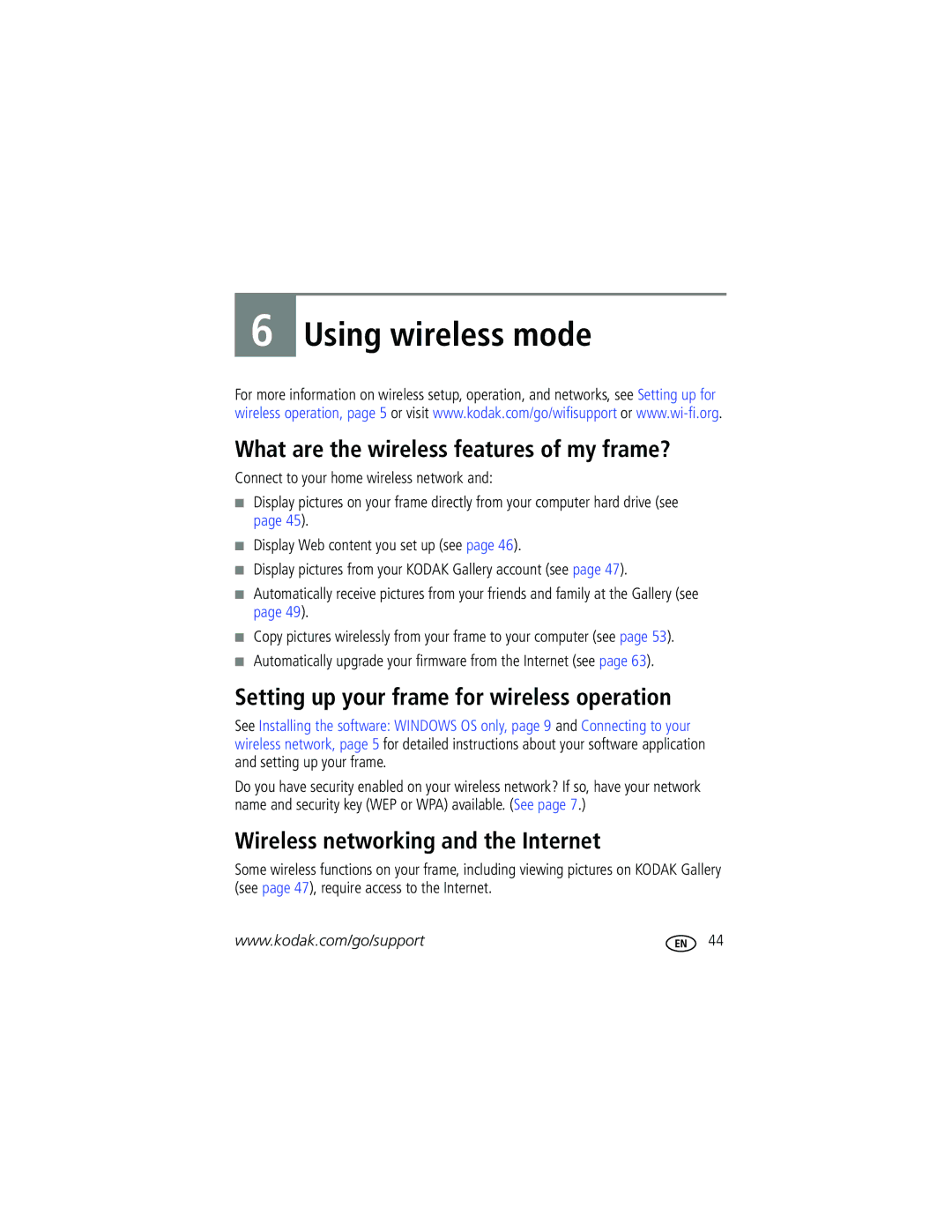Kodak Easyshare
W820/W1020 Wireless Digital Frames
Eastman Kodak Company Rochester, New York
Back/Right View
Front View
Back/Side View
Table of contents
Table of contents
Table of contents
Setting up your frame
Setting up the stand
Getting started
Turning on/off your frame
Attaching the power cable
Slide on bottom border only
Using your frame’s Quick Touch Borders
Touch tips
Don’t hover, borders can be sensitive
Setting your language
Connecting to your wireless network
To use the Quick Touch Borders, see
Scanning for available wireless networks screen appears
Setting up for wireless operation
Available wireless networks are listed
On-screen keyboard appears
If your wireless network is not found
Backspace erases text
Installing the software Windows OS only
Verifying computer/device connections
Network connection setup screen appears
Help Done Exit
Setting up Web content
Setting up access to the Gallery and Web media
Windows OS users
Setting up Web content
Flickr Framechannel
MAC OS users
Go to on page 13 to start configuring your frame
Connecting to your Gallery account
Kodak Gallery Web Media configuration page appears
Select your country/region from the drop-down menu
Connecting to your Flickr account
Flickr Web Media configuration page appears
You can now view photo feeds from Flickr see
Framechannel Web Media configuration page appears
Connecting to your Framechannel account
Photo RSS/FLICKR Add/Edit page appears
How to add a Flickr feed
Adding Web feeds
Click Add
Save
Framechannel Add/Edit page appears
How to add a Framechannel feed
Setting up Web content
From the Site drop-down menu, select Other
How to add feeds from other sites
Click Save
Creating shortcuts on your frame
To preview a feed , click
Previewing, editing, and deleting feeds
Preview Edit Delete
Secure Digital
Viewing on your frame
Enjoying your pictures immediately
Inserting a memory card
Connecting a digital camera or other USB device
Home screen icons
Viewing the Home screen
Viewing on your frame
Highlighted source
Accessing your pictures and videos
Tap Home, then Pictures and Videos
All connected sources are displayed
Icons or from single view, tap Thumbnails
Viewing pictures and videos
Viewing thumbnails multi-up
There are two ways to view your pictures as thumbnails
Viewing a single picture
Other slide show information
Saving your favorite slide show for easy access
Playing a slide show
There are two ways to start a slide show on your frame
Arranging pictures to play by date or filename
Show options Highlight Sort, then tap Select
Date, oldest to newest Date, newest to oldest Tap Save
Doing more with your frame
Playing music
Headphone jack is available on the side of the frame see
Playing a video
Tap Print, then Yes to start printing all selected pictures
Printing to a PictBridge enabled Printer
Printing pictures
Printing of the displayed picture begins
Manually changing USB connection mode
Copying on your frame
Highlight a picture to copy
Picture is copied
Highlight a picture to delete
Deleting pictures
Select all
Selecting multiple pictures
Select/Unselect all
Check mark appears on the selected picture
Wireless networking and the Internet
Using wireless mode
What are the wireless features of my frame?
Setting up your frame for wireless operation
Viewing pictures/videos wirelessly
Before you proceed
On your frame, tap Home → Pictures and Videos
Viewing Gallery/Web media content on your frame
To see all pictures from the Gallery
Viewing Kodak Gallery pictures
Bottom to display the icons, then tap Play slide show
Viewing Web feeds on your frame
Slide show begins. Or
Tap Web Media
To see the shared pictures later
Automatically receiving My Friends Albums
To see the shared pictures right away
Select a marked album from the Gallery list and tap OK
Turning off auto-receive and notification
Assign a nickname to the new email address optional
Emailing pictures and videos from your frame
Adding a new email address
Enter the email address
Select. Tap Select all to send to everyone on your list
Sharing your pictures
Highlight a picture to share
Tap Actions Tap Share
Copying wirelessly to/from your computer
Click Help
Browse to the frame location to which you are copying
Copying pictures from Easyshare Software
Using wireless mode
Tap Home, then Settings
Changing settings and more
Changing frame settings
Settings menus
Screen Fit or Fill
Setting Options Viewing options
Network
Setting Options Clock and timer
Device configuration
Kodak Gallery
Setting the clock and timer
Manually setting the clock
Getting the time from the Internet
Setting automatic on/off
Tap Enable, then Save when you’re done
Current time is displayed and the hour field is highlighted
Upgrading your software and firmware
Manually upgrade firmware
Upgrade right away
Important Do not turn off the frame during the upgrade
Upgrade later
Mounting your frame on the wall
Adding a matte and faceplate
Orientation
Change the frame orientation setting
Changing your frame orientation
Change the stand position and angle
Learning more about your frame
Maintaining your frame and mattes
Frequently asked questions
Can’t find my network. Why?
Can’t find my network computer. Why?
Picture frame problems
Yes, you can
Try one or more of the following
Important Do not slide on the right border tap only
Picture frame/computer communications
Resetting the clock after losing power
Screen messages
Including protected files
Screen message Try one or more of the following
Screen message Try one or more of the following
Appendix
Digital frame specifications
Appendix
Kodak Easyshare W820/W1020 Wireless Digital Frames
Important safety instructions
Additional care and maintenance
Limited warranty
Limited warranty coverage
Limitations
FCC compliance and advisory
Regulatory compliance
Your rights
Outside the United States and Canada
Canadian DOC statement
FCC and Industry Canada
N137
China RoHS
Russian GOST-R
Korean Class B ITE Licensing
About, frame Easyshare Software Appendix
From Easyshare Software Frame To/from computer, USB Home
Screen
Running
Pictbridge enabled Printer, 39 pictures
Cleaning
Running slide show
Features on frame, overview, 44 setup Viewing pictures

